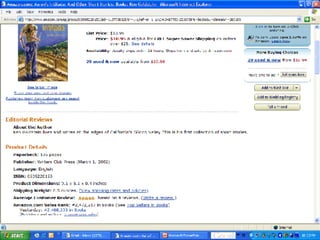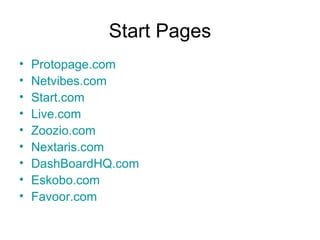Web2.0v2.0
- 1. “ WEB 2.0” – A Primer Robert Gonsalves
- 2. “ I tend to think about the gravitational core that holds a solar system of ideas and experiences together, rather than some kind of box to contain them.” Tim O’Reilly
- 3. What is Web 2.0? An emerging network-centric platform to support distributed, collaborative and cumulative creation by its users John Hagel A new way of starting and running companies - with less capital, more focus on the customer and a far more open business model when it comes to working with others. John Battelle
- 4. Back to the Future In many respects, Web 2.0 represents a return to origins of Internet. The original goal of the pioneers developing and deploying the Internet was to connect researchers and their computers together so that they could more effectively pursue their research in distributed locations. The addition of the World Wide Web in the early 1990 ended up representing a detour from that original vision. Web 1.0 largely consisted of stand-alone web sites for specialized publishers and vendors seeking to more effectively reach audiences and consumers. It was a broadcast and distribution medium, rather than a creation medium. Web 2.0 changes all that. John Hagel
- 5. What is Web 2.0 Web 2.0 is the network as platform, spanning all connected devices; Web 2.0 applications are those that make the most of the intrinsic advantages of that platform: delivering software as a continually-updated service that gets better the more people use it, consuming and remixing data from multiple sources, including individual users, while providing their own data and services in a form that allows remixing by others, creating network effects through an "architecture of participation," and going beyond the page metaphor of Web 1.0 to deliver rich user experiences. Tim O’Reilly
- 6. Web examples – Then vs. Now Web 1.0 DoubleClick--> Ofoto--> Akamai--> mp3.com--> Britannica Online--> personal websites--> evite--> domain name speculation--> page views--> screen scraping--> publishing--> content management systems--> directories (taxonomy)--> stickiness--> Web 2.0 Google AdSense Flickr BitTorrent Napster Wikipedia blogging upcoming.org and EVDB search engine optimization cost per click web services participation Wikis tagging ("folksonomy") syndication Tim O'Reilly
- 7. Tim O'Reilly
- 8. Web 2.0 Design Patterns In this book, A Pattern Language, Christopher Alexander prescribes a format for the concise description of the solution to architectural problems. He writes:" Each pattern describes a problem that occurs over and over again in our environment, and then describes the core of the solution to that problem, in such a way that you can use this solution a million times over, without even doing it the same way twice.” Tim O'Reilly
- 9. Web 2.0 Design Patterns The Long Tail Data is the Next Intel Inside Users Add Value Network Effects by Default Some Rights Reserved The Perpetual Beta Cooperate, Don’t Control Software Above the Level of a Single Device Tim O'Reilly
- 10. The Long Tail Small sites make up the bulk of the internet’s content: narrow niches make up the bulk of internet’s the possible applications. Therefore: Leverage customer-self service and algorithmic data management to reach out to the entire web, to the edges and not just the center, to the long tail and not just the head.
- 12. Data is the Next Intel Inside Applications are increasingly data-driven. Therefore : For competitive advantage, seek to own a unique, hard-to-recreate source of data.
- 14. Users Add Value The key to competitive advantage in internet applications is the extent to which users add their own data to that which you provide. Therefore: don’t restrict your “architecture of participation” to software development. Involve your users both implicitly and explicitly in adding value to your application.
- 16. Network Effects by Default Only a small percentage of users will go to the trouble of adding value to your application. Therefore: Set inclusive defaults for aggregating user data as a side-effect of their use of the application.
- 18. Some Rights Reserved Intellectual property protection limits re-use and prevents experimentation. Therefore: When benefits come from collective adoption, not private restriction, make sure that barriers to adoption are low. Follow existing standards, and use licenses with as few restrictions as possible. Design for “hackability” and “remixability.”
- 20. The Perpetual Beta When devices and programs are connected to the internet, applications are no longer software artifacts, they are ongoing services. Therefore: Don’t package up new features into monolithic releases, but instead add them on a regular basis as part of the normal user experience. Engage your users as real-time testers, and instrument the service so that you know how people use the new features.
- 22. Cooperate, Don’t Control Web 2.0 applications are built of a network of cooperating data services. Therefore: Offer web services interfaces and content syndication, and re-use the data services of others. Support lightweight programming models that allow for loosely-coupled systems.
- 24. Lightweight Programming AJAX / Scripting Languages "Ajax isn't a technology. It's really several technologies, each flourishing in its own right, coming together in powerful new ways. Ajax incorporates: standards-based presentation using XHTML and CSS; dynamic display and interaction using the Document Object Model; data interchange and manipulation using XML and XSLT; asynchronous data retrieval using XMLHttpRequest; and JavaScript binding everything together." Web 2.0 companies focus on scripting languages such as Perl, Python, PHP, and now Ruby on Rails.
- 25. Software Above the Level of a Single Device The PC is no longer the only access device for internet applications, and applications that are limited to a single device are less valuable than those that are connected. Therefore: Design your application from the get-go to integrate services across handheld device. PCs, and internet servers.
- 27. Core Competencies of Web 2.0 Companies “ The Web As Platform “ Services, not packaged software, with cost-effective scalability Control over unique, hard-to-recreate data sources that get richer as more people use them Rich User Experiences Trusting users as co-developers and the end of the Software Release Cycle Harnessing collective intelligence Leveraging the long tail through customer self-service Software above the level of a single device Lightweight user interfaces, development models, AND business models Tim O’Reilly
- 29. Implications for our business How does “Web 2.0” change how we think about our audience? How does “Web 2.0” inform our design choices for the 2 nd 10 years of Disney Online? Where do you want to go…tomorrow?
- 30. Not all sites links are attached http://webosphere.wordpress.com/
- 31. Videos Clipshack.com Castpost.com Vsocial.com Dailymotion.com Youtube.com
- 32. Start Pages Protopage.com Netvibes.com Start.com Live.com Zoozio.com Nextaris.com DashBoardHQ.com Eskobo.com Favoor.com
- 33. Music & Movies Pandora.com LivePlasma.com Music-Map.com Indy.com Discogs.com Movielens.com Lastfm.com YMDB.com Musicstrands.com Myfilmz.net Muiso.com
- 34. Photos Fotopic.net Flickr.com Photosite.com 43places.com 23HQ.com Zoto.com PhotoBucket.com Bubbleshare.com Hello.com Fotolia.com Riya.com Fotoflix.com Fotothing.com Zorpia.com ShutterBook.com
- 35. Podcasting Castpost.com Inkysoftware.com Odeo.com Vodstock.com Videoegg.com Shockpod.com Feed2Podcast.com
- 36. Bookmarks http://del.icio.us/ Netvouz.com Simpy.com Blogmarks.net Furl.com Spurl.com Filangy.com Reddit.com Rawsugar.com Linkagogo.com Chipmark.com Yummy.printfu.org Blinklist.com Jots.com Shadows.com Oyax.com
- 37. Documents Writely.com MoonEdit.com Writeboard.com WebCollaborator.com WideWord.net RallyPointhq.com ZohoWriter.com
- 38. Networking Viaduc.com OpenBC.com MySpace.com Orkut.com Ryze.com Linkedin.com
- 39. To Do Lists Tasktoy.com Blablalist.com BackPackit.com TaDaList.com Zohoplanner.com Tudu lists Gootodo.com Rememberthemilk.com SproutLiner.com
- 40. Spread Sheets NumSum.com Trackslife.com tracker.jot.com
- 41. Calendars Planzo.com Kiko.com CalendarHub.com Airset.com Goowy.com Calendars.net RainLender.com Ifreebusy.com Upcoming.org EventSniper.com Trumba.com HipCal.com
- 42. Peer Production Digg.com diggdot.us Reddit.com Gabbr.com PeopleFeeds.com SpinSpy.com 180n.com










































